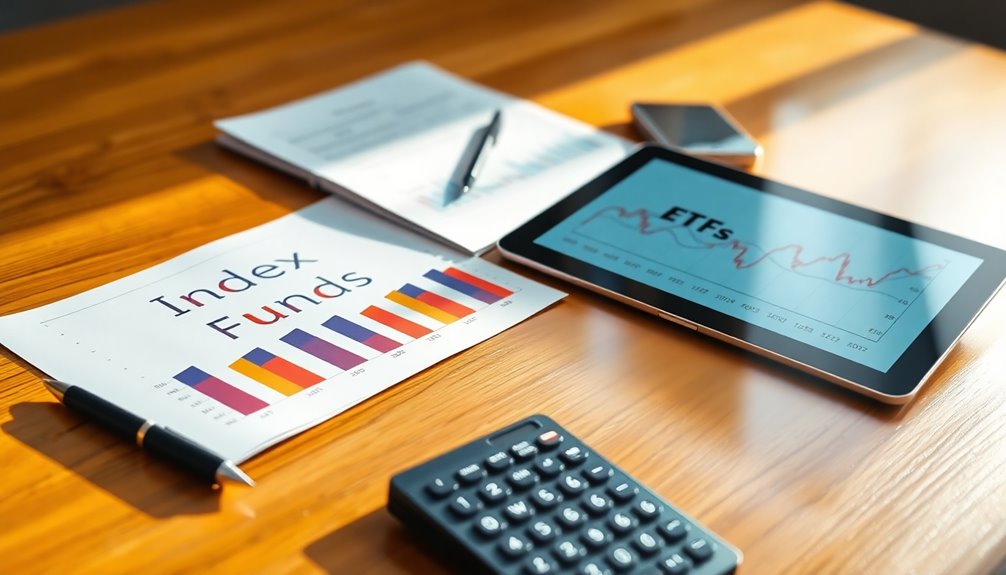Index funds and ETFs are simple, low-cost options perfect for beginners. They let you invest across many companies by tracking a market index, providing instant diversification and steady growth. ETFs trade throughout the day like stocks, giving you more flexibility, while index funds trade once daily. By choosing these options, you can build a balanced, long-term portfolio without complex strategies. Keep exploring to discover how to make the most of these easy investment tools.
Key Takeaways
- Index funds and ETFs offer passive investment options that track market indices for broad diversification and steady growth.
- ETFs provide intraday trading flexibility, while index funds trade once daily at their net asset value (NAV).
- Both are low-cost, tax-efficient, making them ideal choices for beginners seeking long-term investment growth.
- Building a diversified portfolio involves spreading investments across sectors, regions, and asset classes using these funds.
- Avoid market timing; focus on consistent, disciplined investing to grow wealth steadily over time.
Understanding the Basics of Index Funds and ETFs

Have you ever wondered how investors can buy into a broad market with just one purchase? That’s the power of index funds and ETFs. They track a specific market index, which represents the overall market’s performance, based on market capitalization. Market capitalization is the total value of a company’s outstanding shares, and it helps determine how much influence each company has within the index. These funds are designed for passive investing, meaning they aim to replicate the index’s performance rather than trying to outperform it. By investing in an index fund or ETF, you get instant diversification across many companies, reducing risk and making investing simpler. This approach is ideal for beginners seeking steady growth without the complexity of picking individual stocks. Additionally, understanding IRA Investment Strategies can help you incorporate these funds into your retirement planning for tax advantages and long-term growth. Moreover, some index funds and ETFs include features like inflation protection—such as those linked to market indices that tend to grow over time—adding an extra layer of security for your investments. For example, diversification through broad market exposure can help mitigate the impact of poor performance in individual stocks or sectors. Incorporating assets like Gold IRAs can also serve as a hedge against inflation within a diversified portfolio. Furthermore, advancements in automated investment platforms have made it easier for beginners to access and manage these funds with minimal effort.
How Do Index Funds and ETFs Work?
Ever wonder how index funds and ETFs actually track the market? They mirror the performance of a specific index by holding the same securities in the same proportions. This passive strategy means your investment moves with the market, not against it. Additionally, their structure allows for dividend strategies that can be tailored to your financial goals. The use of advanced tracking methods ensures these funds closely follow their target indices, minimizing tracking error. Because of their structure, index funds and ETFs often have favorable tax implications and flexible dividend strategies, making them ideal for beginner investors wanting steady growth without the complexity. Their cost efficiency is another key advantage, reducing expenses and maximizing returns over time. Familiarity with regional legal resources can also help investors understand the regulations and protections related to these investment vehicles, especially if investing through different platforms or jurisdictions. Incorporating knowledge of oxidative stress and its effects can also help investors appreciate the importance of diversification and risk management in their portfolios.
The Benefits of Choosing Index Funds and ETFs

Choosing index funds and ETFs offers several compelling benefits that make them popular options for investors. One key advantage is their tax efficiency; because they often have lower turnover than actively managed funds, you’ll face fewer capital gains taxes. This means more of your money stays invested and works for you. Additionally, index funds and ETFs provide broad market coverage, allowing you to effortlessly diversify across many companies and sectors. This diversification reduces risk and helps you capture overall market growth without having to pick individual stocks. Both options are typically low-cost, saving you money on fees compared to actively managed funds. Moreover, they often include specialized functions like targeted exposure to specific industries or themes, further enhancing your investment strategy. Incorporating passive investing strategies through index funds and ETFs can also help you stay disciplined and avoid emotional decision-making. Furthermore, the simplicity of managing these funds makes them particularly suitable for beginners, helping new investors build confidence in their investment journey. Additionally, their passive nature aligns with a long-term growth mindset, which is essential for building wealth over time. Embracing personal empowerment through informed investment choices can also motivate you to learn more about financial strategies. Overall, their combination of tax efficiency and extensive market coverage makes index funds and ETFs smart choices for building a solid, long-term investment foundation.
Comparing Index Funds and ETFs: Which Is Right for You?

When choosing between index funds and ETFs, you’ll want to contemplate costs and fees, as they can vary considerably. Trading flexibility also plays a key role, especially if you prefer to buy and sell shares throughout the day. Understanding these differences helps you decide which option aligns best with your investing style. Additionally, considering the cost structure of these investment options can provide insights into long-term savings and performance. Moreover, awareness of market transparency and how it influences investor decisions can also be beneficial. Being aware of the for sale 100 status can help you better assess the liquidity and availability of specific funds or ETFs in the market.
Cost and Fees
Understanding the costs and fees associated with index funds and ETFs is essential to making a smart investment decision. Your expenses directly impact your returns, so it’s vital to compare them carefully. Index funds often have low expense ratios and management fees, making them a cost-effective choice for long-term investing. ETFs, while sometimes slightly more expensive, can offer flexibility that might justify the additional cost. Here’s a quick comparison:
| Cost Factor | Index Funds | ETFs |
|---|---|---|
| Expense Ratios | Usually below 0.2% | Similar or slightly higher |
| Management Fees | Typically low, passive funds | Slightly higher, active options available |
| Additional Fees | Possible minimum investments | Trading commissions possible |
Additionally, understanding the cost structures of these investment options can help optimize your portfolio’s efficiency and align with your investment goals. Recognizing the personality traits of different fund managers can also influence your choice of investment vehicle. Being aware of the recurring costs involved can further aid in maintaining a balanced and effective investment strategy. Moreover, evaluating fund performance regularly can ensure your investments remain aligned with your financial objectives.
Trading Flexibility
Trading flexibility is an important factor to evaluate alongside costs when selecting between index funds and ETFs. Your ability to buy or sell quickly depends on liquidity options and trading hours. ETFs offer more flexibility because you can trade them throughout the day during market hours, just like stocks. Index funds, on the other hand, only allow trading at the end of the trading day at the net asset value (NAV). Consider these points:
- ETFs provide intraday trading, so you can react to market changes instantly.
- Index funds only trade once daily, limiting responsiveness.
- Liquidity options for ETFs are generally better, especially in high-volume funds.
- Trading hours for ETFs align with stock markets, offering more control.
- Additionally, the sustainability and innovation aspects of ETFs, such as those focusing on modern themes like Nike Tech, can influence your investment choices based on your preferences.
- Understanding market hours and liquidity can help you optimize your trading strategy and take advantage of intraday price movements. Knowing the price volatility of specific ETFs can also help you time your trades more effectively.
How to Get Started With Investing in Index Funds and ETFS

Getting started with investing in index funds and ETFs is straightforward once you know the basics. First, open a brokerage account that offers low fees and easy access. Unlike trying to time the market, focus on consistent investing to benefit from dollar-cost averaging, which helps manage risk. Index funds and ETFs are tax-efficient because they typically generate fewer capital gains, making them ideal for long-term growth. Decide how much money you want to invest regularly and set up automatic transfers if possible. Avoid stressing over market timing—these investments are designed for the long haul. With minimal effort, you can build a solid foundation for your portfolio by choosing broad-market index funds or ETFs that align with your financial goals.
Tips for Building a Diversified Portfolio With These Investment Options

To build a well-diversified portfolio with index funds and ETFs, focus on spreading your investments across different asset classes, sectors, and geographic regions. Effective sector allocation helps manage risk by avoiding overconcentration in one area. Here are some tips:
- Diversify across sectors like technology, healthcare, and consumer goods to balance growth and stability.
- Invest in international ETFs to reduce dependence on your home country’s economy.
- Mix bond and stock index funds to improve risk management and cushion against market volatility.
- Regularly rebalance your portfolio to maintain your desired asset allocation and sector diversification.
Common Mistakes to Avoid When Investing in Index Funds and ETFs

While index funds and ETFs offer a straightforward way to invest, many investors overlook common pitfalls that can undermine their returns. One key mistake is falling victim to timing challenges, trying to buy low and sell high, which often leads to missed opportunities and increased stress. Instead, focus on consistent, long-term investing. Emotional investing is another trap; reacting to market swings can prompt impulsive decisions that hurt your portfolio. Avoid panic selling when markets dip or making impulsive buys during hype. Keep a disciplined approach, stay patient, and stick to your plan. By recognizing these mistakes, you’ll be better equipped to navigate market fluctuations and grow your investments steadily over time.
Frequently Asked Questions
Are Index Funds and ETFS Suitable for Long-Term Investing?
You’re wondering if index funds and ETFs are good for long-term investing. They offer great diversification benefits, helping you spread risk across many assets. Unlike market timing strategies, which try to guess market moves, these investments focus on steady growth over time. By holding them long-term, you can reduce stress and avoid costly mistakes, making them an excellent choice for building wealth gradually.
How Do Expense Ratios Impact Investment Returns?
The saying “penny wise, pound foolish” fits when considering expense ratios. Your investment returns can be considerably impacted by the management fee included in the expense ratio. A higher expense ratio eats into your gains over time, reducing the growth of your investments. Choosing funds with lower expense ratios means more of your money stays invested, helping you maximize your returns without paying unnecessary fees.
Can I Buy and Sell Index Funds and ETFS Anytime?
You can buy and sell index funds and ETFs through your brokerage account during trading hours, usually from 9:30 a.m. to 4:00 p.m. EST on weekdays. Outside these hours, trading isn’t available, but you can place orders that execute when the market opens. Remember, trading outside normal hours can involve additional risks and lower liquidity, so it’s best to plan your transactions during regular trading times.
What Are the Tax Implications of Investing in ETFS?
When you invest in ETFs, you’ll want to consider tax implications like capital gains. ETFs are generally tax-efficient because of their structure, which helps minimize capital gains implications compared to other investments. Using tax-efficient strategies, such as holding ETFs long-term or investing in tax-advantaged accounts, can further reduce your tax burden. Always stay aware of how your transactions might impact your taxes, and consult a tax professional for personalized advice.
How Often Should I Rebalance My Index Fund and ETF Portfolio?
You should rebalance your portfolio periodically to maintain your desired risk level. Generally, aim for once or twice a year, or if your portfolio drifts more than 5-10% from your target allocation. Regular portfolio rebalancing helps manage risk and keeps your investments aligned with your goals. Staying disciplined with rebalancing guarantees you don’t take on too much risk or miss growth opportunities, supporting effective risk management over time.
Conclusion
Getting started with index funds and ETFs is simpler than you think. Imagine your money growing steadily, like a tree expanding its branches, without the stress of picking individual stocks. Even if you’re worried about market fluctuations, these funds offer stability and diversification. Just take that first step—you’ll be building a strong, resilient portfolio that can weather ups and downs. Start today, and watch your investments grow with confidence.









